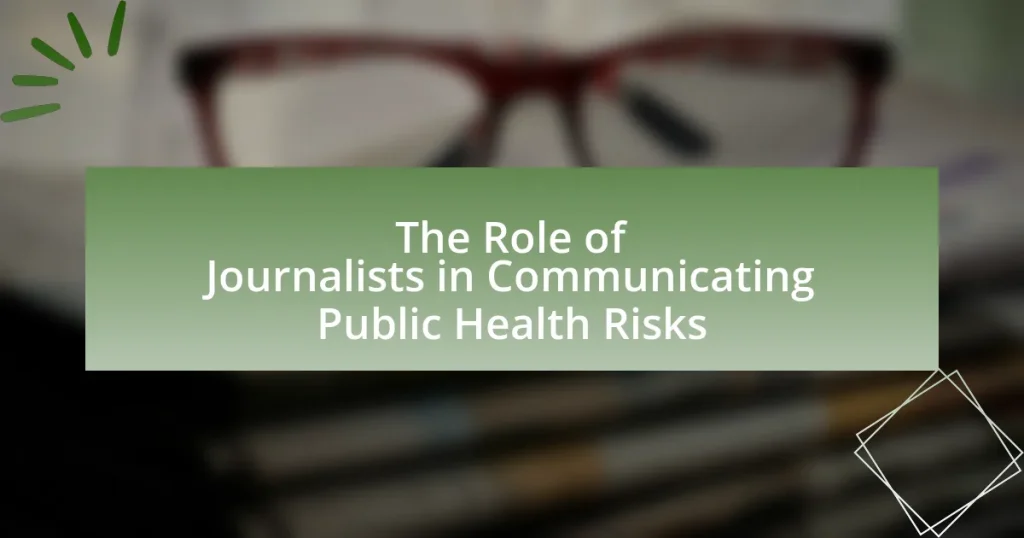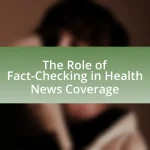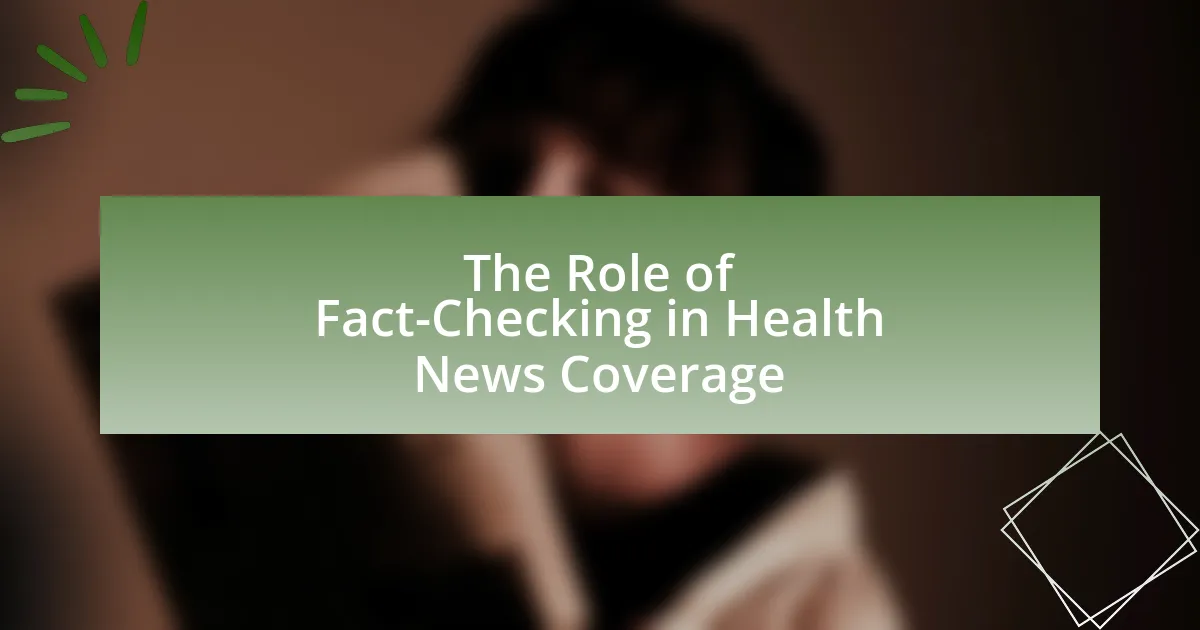The article examines the critical role of journalists in communicating public health risks, emphasizing their responsibility to inform the public about potential threats and necessary precautions. It discusses how journalists influence public perception through narrative framing and the methods they employ to convey health information, including articles, interviews, and multimedia content. The piece highlights the importance of accurate communication, the consequences of misinformation, and the ethical considerations journalists must navigate. Additionally, it addresses the challenges faced in health reporting, the significance of collaboration with health experts, and strategies for effective communication during public health crises.
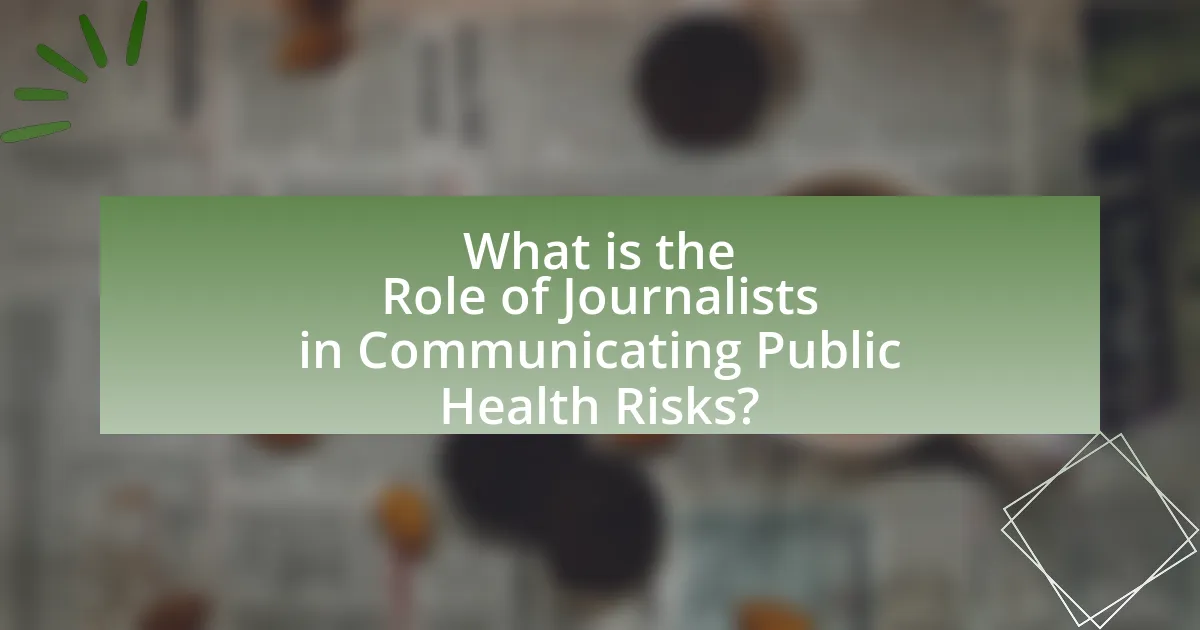
What is the Role of Journalists in Communicating Public Health Risks?
Journalists play a crucial role in communicating public health risks by informing the public about potential threats and necessary precautions. They gather, verify, and disseminate information from credible sources, such as health organizations and experts, ensuring that the public receives accurate and timely updates. For instance, during the COVID-19 pandemic, journalists reported on transmission rates, vaccine developments, and health guidelines, which helped shape public understanding and response. Their work is essential in combating misinformation and fostering informed decision-making among communities.
How do journalists influence public perception of health risks?
Journalists influence public perception of health risks by shaping narratives and framing issues through their reporting. Their choice of language, emphasis on certain aspects of health stories, and the selection of sources can significantly impact how the public understands and reacts to health information. For instance, studies have shown that sensationalized reporting on health crises, such as the Ebola outbreak, led to increased fear and anxiety among the public, highlighting the power of media framing in shaping perceptions. Furthermore, journalists often serve as intermediaries between scientific communities and the public, translating complex health data into accessible information, which can either clarify or confuse public understanding depending on the accuracy and context provided in their reports.
What methods do journalists use to convey health information?
Journalists use various methods to convey health information, including news articles, interviews with experts, infographics, and multimedia content. News articles provide detailed reports on health issues, while interviews with healthcare professionals offer expert insights and personal stories that enhance understanding. Infographics visually represent complex data, making it easier for the audience to grasp key health statistics and trends. Multimedia content, such as videos and podcasts, engages audiences through storytelling and discussions, further disseminating important health information. These methods are effective in reaching diverse audiences and ensuring that critical health messages are communicated clearly and accurately.
How does the framing of health risks affect public understanding?
The framing of health risks significantly influences public understanding by shaping perceptions and responses to those risks. When health risks are framed in a way that emphasizes urgency or severity, such as highlighting potential fatalities or widespread outbreaks, the public is more likely to perceive these risks as immediate threats, leading to heightened concern and behavioral changes. For example, during the COVID-19 pandemic, media coverage that framed the virus as a severe and imminent danger prompted widespread compliance with health guidelines, as evidenced by increased mask-wearing and social distancing behaviors. Conversely, framing that downplays risks or presents them as less serious can lead to complacency and reduced public engagement with health measures. Research by the Pew Research Center indicates that how information is presented—whether through statistics, narratives, or visual imagery—can significantly alter public perception and understanding of health risks, ultimately affecting health outcomes.
Why is accurate communication of public health risks essential?
Accurate communication of public health risks is essential because it directly influences public behavior and health outcomes. When information about health risks is conveyed clearly and accurately, individuals are more likely to take appropriate actions, such as vaccination or adhering to safety guidelines, which can significantly reduce the spread of diseases. For instance, during the COVID-19 pandemic, accurate messaging about transmission and prevention measures was crucial in shaping public compliance with health directives, ultimately impacting infection rates and healthcare system capacity.
What are the potential consequences of misinformation in health reporting?
Misinformation in health reporting can lead to severe consequences, including public health crises, increased morbidity and mortality, and erosion of trust in health authorities. For instance, during the COVID-19 pandemic, false information about treatments and preventive measures resulted in individuals ignoring scientifically backed guidelines, contributing to higher infection rates. A study published in the journal “Health Affairs” found that misinformation significantly influenced public behavior, leading to a 20% increase in risky health practices. Additionally, misinformation can cause confusion and anxiety among the public, undermining effective communication from health professionals and creating barriers to achieving public health goals.
How can journalists ensure the accuracy of their health-related stories?
Journalists can ensure the accuracy of their health-related stories by rigorously fact-checking information and consulting credible sources. This involves verifying data from peer-reviewed studies, official health organizations, and expert interviews to confirm the validity of the claims made in their articles. For instance, a study published in the Journal of Health Communication emphasizes the importance of using reliable sources to enhance the credibility of health reporting. By adhering to these practices, journalists can provide accurate and trustworthy information to the public, thereby fulfilling their role in effectively communicating public health risks.
What challenges do journalists face in reporting health risks?
Journalists face significant challenges in reporting health risks, primarily due to the complexity of scientific information and the need for accuracy. The intricate nature of health data often requires journalists to have a strong understanding of medical terminology and research methodologies, which can be difficult without specialized training. Additionally, the pressure to produce timely stories can lead to oversimplification or misinterpretation of health risks, potentially spreading misinformation. A study published in the Journal of Health Communication highlights that 60% of health news stories contain inaccuracies, underscoring the difficulty journalists encounter in balancing speed with factual reporting. Furthermore, journalists must navigate public and governmental pressures, which can influence how health risks are portrayed, complicating their role as objective informers.
How do time constraints impact the quality of health reporting?
Time constraints significantly diminish the quality of health reporting by limiting journalists’ ability to conduct thorough research and verify information. When journalists face tight deadlines, they often prioritize speed over accuracy, leading to the dissemination of incomplete or misleading information. A study published in the Journal of Health Communication found that rushed reporting frequently results in errors, such as misinterpretation of data or failure to include critical context, which can misinform the public about health risks. This reduction in quality not only undermines the credibility of the reporting but also poses risks to public health by spreading misinformation.
What role does access to reliable sources play in health journalism?
Access to reliable sources is crucial in health journalism as it ensures the accuracy and credibility of information disseminated to the public. Journalists rely on verified data, expert opinions, and peer-reviewed studies to report on health issues, which helps prevent the spread of misinformation. For instance, during the COVID-19 pandemic, health journalists who utilized reliable sources from organizations like the World Health Organization and the Centers for Disease Control and Prevention were able to provide accurate updates and guidance, thereby fostering public trust and informed decision-making. This reliance on credible sources not only enhances the quality of reporting but also plays a vital role in shaping public understanding of health risks and promoting effective health communication.
How can journalists improve their communication strategies for public health?
Journalists can improve their communication strategies for public health by utilizing clear, accurate, and accessible language tailored to diverse audiences. This approach ensures that complex health information is understandable, which is crucial for effective public engagement. Research indicates that using plain language increases comprehension and retention of health messages, as demonstrated in studies by the Centers for Disease Control and Prevention, which found that simplified health communication significantly enhances public understanding. Additionally, incorporating visual aids and infographics can further clarify information, making it more engaging and easier to digest. By prioritizing these strategies, journalists can foster better public awareness and response to health issues.
What training or resources are available for journalists covering health topics?
Journalists covering health topics can access various training programs and resources designed to enhance their reporting skills. Organizations such as the Association of Health Care Journalists (AHCJ) offer workshops, webinars, and online courses focused on health reporting, data analysis, and understanding medical research. Additionally, the National Institutes of Health (NIH) provides resources like the NIH News in Health newsletter, which helps journalists stay informed about the latest health research and trends. These resources are crucial for journalists to accurately communicate public health risks and ensure informed reporting.
How can collaboration with health experts enhance reporting quality?
Collaboration with health experts enhances reporting quality by ensuring accuracy and depth in health-related stories. Journalists gain access to specialized knowledge, which allows them to present complex medical information clearly and correctly. For instance, a study published in the Journal of Health Communication found that articles co-authored by health professionals had a significantly higher accuracy rate compared to those written solely by journalists. This collaboration also helps in identifying relevant public health issues, thereby improving the relevance and impact of the reporting.
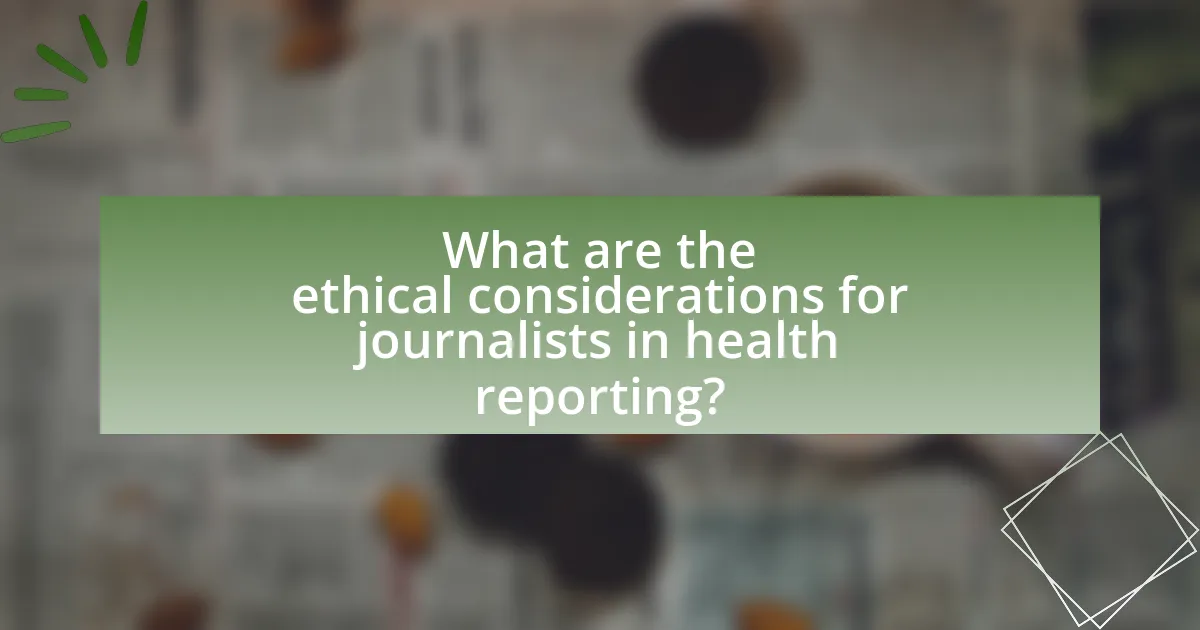
What are the ethical considerations for journalists in health reporting?
Ethical considerations for journalists in health reporting include accuracy, transparency, and sensitivity to the potential impact of their reporting on public health. Journalists must ensure that the information they present is factually correct and based on credible sources, as misinformation can lead to public panic or harm. Transparency involves disclosing conflicts of interest and the sources of information, which builds trust with the audience. Additionally, journalists should approach sensitive health topics with empathy, considering the emotional and social implications for individuals and communities affected by health issues. These ethical standards are essential for maintaining the integrity of health journalism and ensuring that the public receives reliable information.
How do ethical standards guide health journalism?
Ethical standards guide health journalism by establishing principles that ensure accuracy, fairness, and accountability in reporting health-related information. These standards compel journalists to verify facts, seek multiple sources, and present information in a balanced manner, which is crucial in preventing misinformation that can impact public health decisions. For instance, adherence to the Society of Professional Journalists’ Code of Ethics emphasizes the importance of minimizing harm and acting independently, which directly influences how health stories are reported and perceived by the public. This commitment to ethical reporting fosters trust between journalists and their audience, ultimately enhancing the effectiveness of communication in public health contexts.
What are the implications of sensationalism in health news?
Sensationalism in health news leads to misinformation and public panic, undermining trust in health communication. When journalists prioritize dramatic headlines over factual reporting, they can distort the severity of health issues, causing audiences to react irrationally. For instance, a study published in the Journal of Health Communication found that sensationalized reporting on the H1N1 virus led to increased anxiety and vaccine hesitancy among the public. This demonstrates that sensationalism not only misguides public perception but also negatively impacts health behaviors and outcomes.
How can journalists balance public interest with ethical reporting?
Journalists can balance public interest with ethical reporting by adhering to established ethical guidelines while prioritizing transparency and accuracy. Ethical frameworks, such as the Society of Professional Journalists’ Code of Ethics, emphasize the importance of seeking truth, minimizing harm, and acting independently. For instance, when reporting on public health risks, journalists should verify information from credible sources, such as the Centers for Disease Control and Prevention or the World Health Organization, to ensure that the public receives accurate and reliable information. This approach not only serves the public interest by providing essential health information but also upholds ethical standards by preventing the spread of misinformation.
What role does transparency play in health journalism?
Transparency in health journalism is crucial for building trust between journalists, the public, and health authorities. It ensures that information is accurate, verifiable, and free from bias, which is essential for effective communication of public health risks. For instance, during the COVID-19 pandemic, transparent reporting on data sources and methodologies helped the public understand the evolving nature of the virus and the rationale behind health guidelines. Studies have shown that transparency in reporting can lead to increased public compliance with health recommendations, as seen in research published by the American Journal of Public Health, which highlights the correlation between transparent communication and public trust in health messaging.
How can journalists disclose conflicts of interest in health reporting?
Journalists can disclose conflicts of interest in health reporting by clearly stating any financial, personal, or professional relationships that may influence their reporting. This transparency allows readers to assess the credibility of the information presented. For instance, if a journalist has received funding from a pharmaceutical company, they should explicitly mention this in their article. Research indicates that transparency in disclosing conflicts of interest enhances trust in journalism and helps maintain ethical standards in reporting, as highlighted by the American Medical Association’s guidelines on conflict of interest disclosures.
What practices promote trust between journalists and the public?
Practices that promote trust between journalists and the public include transparency, accuracy, and accountability. Transparency involves journalists openly sharing their sources and methods, which helps the public understand how information is gathered. Accuracy is crucial; journalists must fact-check their information and provide context to avoid misinformation. Accountability means that journalists should be willing to correct errors and engage with the audience, fostering a sense of responsibility. Research by the Pew Research Center indicates that 62% of Americans believe that journalists should be transparent about their sources to build trust. These practices collectively enhance credibility and foster a positive relationship between journalists and the public.
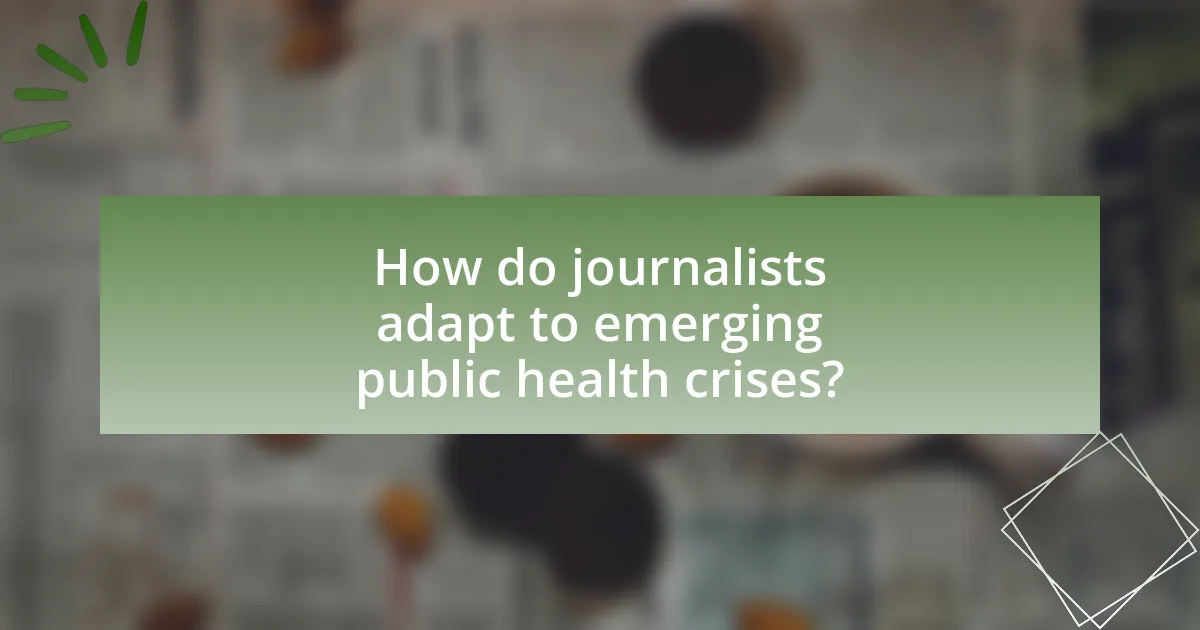
How do journalists adapt to emerging public health crises?
Journalists adapt to emerging public health crises by rapidly gathering and disseminating accurate information, often collaborating with health experts and utilizing various media platforms to reach diverse audiences. During the COVID-19 pandemic, for instance, journalists shifted their reporting strategies to include real-time updates, fact-checking, and addressing misinformation, which was crucial in keeping the public informed. This adaptability is supported by the need for timely communication, as studies show that effective public health messaging can significantly influence community behavior and compliance with health guidelines.
What strategies do journalists employ during health emergencies?
Journalists employ several strategies during health emergencies, including fact-checking, sourcing expert opinions, and utilizing clear communication. Fact-checking ensures the accuracy of information disseminated to the public, which is crucial during crises where misinformation can lead to panic or harmful behaviors. Sourcing expert opinions from healthcare professionals and scientists provides credibility and context to the information shared, helping the audience understand the severity and implications of the health emergency. Clear communication involves using accessible language and formats to convey complex health information effectively, ensuring that diverse audiences can comprehend the risks and recommended actions. These strategies are essential for maintaining public trust and promoting informed decision-making during health crises.
How do journalists prioritize information during a crisis?
Journalists prioritize information during a crisis by assessing the relevance, urgency, and impact of the information on public safety and awareness. They focus on verifying facts quickly, determining which details are most critical for the audience’s understanding of the situation, and ensuring that the information is accurate and timely. For instance, during the COVID-19 pandemic, journalists prioritized updates on infection rates, safety guidelines, and vaccine availability, as these directly affected public health decisions and behaviors. This prioritization is essential for effective communication and helps to mitigate misinformation during high-stakes situations.
What lessons have been learned from past public health crises?
Past public health crises have taught several critical lessons, particularly regarding the importance of clear communication and timely information dissemination. For instance, during the Ebola outbreak in West Africa (2014-2016), the World Health Organization emphasized that effective communication strategies were essential in managing public fear and misinformation. Additionally, the COVID-19 pandemic highlighted the necessity for journalists to provide accurate, science-based information to combat the spread of false narratives, as seen in the rapid dissemination of misinformation on social media platforms. These experiences underscore the vital role journalists play in shaping public understanding and response during health emergencies.
How can journalists effectively communicate evolving health information?
Journalists can effectively communicate evolving health information by prioritizing accuracy, clarity, and timely updates. They should verify facts through reliable sources, such as peer-reviewed studies or health organizations, to ensure the information is credible. For instance, during the COVID-19 pandemic, journalists relied on data from the World Health Organization and the Centers for Disease Control and Prevention to provide accurate updates on transmission rates and vaccination guidelines. Additionally, using clear language and avoiding medical jargon helps make complex health information accessible to the general public. Engaging with experts and incorporating diverse perspectives can also enhance the depth and reliability of the information presented.
What tools and platforms can enhance real-time health reporting?
Real-time health reporting can be enhanced by tools and platforms such as health information systems, mobile applications, and data visualization software. Health information systems like Electronic Health Records (EHRs) enable the collection and sharing of patient data in real-time, facilitating timely reporting. Mobile applications, such as those developed for disease tracking or symptom monitoring, allow users to report health data instantly, improving responsiveness. Data visualization software, such as Tableau or Power BI, helps journalists present complex health data in an accessible format, making it easier for the public to understand health risks. These tools collectively improve the accuracy and speed of health reporting, which is crucial during public health emergencies.
How can journalists engage with the audience during health crises?
Journalists can engage with the audience during health crises by utilizing multiple communication channels, including social media, live updates, and interactive platforms. These methods allow journalists to provide real-time information, answer audience questions, and address misinformation directly. For instance, during the COVID-19 pandemic, many journalists used Twitter and Facebook to share updates and engage in discussions, which helped to clarify public concerns and disseminate accurate information. This approach not only fosters trust but also encourages community involvement, as seen in various health campaigns where audience feedback shaped the narrative.
What best practices should journalists follow when reporting on public health risks?
Journalists should prioritize accuracy, clarity, and context when reporting on public health risks. Accuracy involves verifying information through reliable sources, such as public health officials or peer-reviewed studies, to prevent the spread of misinformation. Clarity requires journalists to use straightforward language that is accessible to the general public, avoiding jargon that may confuse readers. Providing context is essential; journalists should explain the significance of the health risk, including statistics or historical data, to help the audience understand its impact. For instance, during the COVID-19 pandemic, journalists who reported on infection rates and vaccination statistics accurately informed the public about the severity of the situation, which was crucial for public compliance with health guidelines.
How can journalists ensure they are providing balanced perspectives?
Journalists can ensure they are providing balanced perspectives by actively seeking diverse viewpoints and verifying information from multiple sources. This approach helps to mitigate bias and present a comprehensive view of public health issues. For instance, when reporting on a health crisis, journalists should include insights from health experts, affected individuals, and community leaders to capture the full spectrum of opinions and experiences. Research indicates that balanced reporting enhances public understanding and trust; a study by the Pew Research Center found that audiences are more likely to engage with news that reflects a variety of perspectives.
What are the key takeaways for journalists covering health topics?
Key takeaways for journalists covering health topics include ensuring accuracy, understanding scientific context, and communicating clearly. Journalists must verify information through credible sources, such as peer-reviewed studies or expert interviews, to maintain credibility and avoid misinformation. Additionally, they should grasp the nuances of health data, including statistics and epidemiology, to provide context that helps the audience understand the implications of health issues. Clear communication is essential; using plain language and avoiding jargon makes health information accessible to a broader audience. These practices are vital for effective public health communication, as evidenced by the role of accurate reporting in managing public responses during health crises, such as the COVID-19 pandemic.
